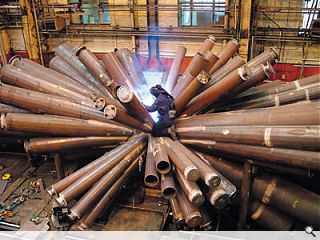The Art of Structure. Iconic engineering taken to the limit.
20 Sep 2004
The beautiful Menai suspension bridge, that joins Anglesey to Wales and was completed in 1826, was the world’s first iron suspension bridge, having a span of over 500 feet.
Its creator, Thomas Telford, had earlier stated he believed that engineering was “the art of directing the great source of power in nature for the use and convenience of man”. His philosophy reinforced the common professional ambition of the time – pushing beyond technological boundaries – whilst also seemingly alluding to references of a more altruistic nature. The physical form and juxtaposition of the Menai Bridge appear to consider its engineering as an organic structure and composition, and it remains to this day a sublime example of iconic public art – realised unconsciously on an ambitious scale.
Now, as then, the gap between success and failure in such innovative undertakings is slender. The consequences of the latter today are often more dire and long-lasting in terms of hype rather than through catastrophe – as evidenced in the furore surrounding the famous “wobble” on the London Millennium Bridge (‘Blade of Light’) by Foster & Partners and Arup. Despite these potential setbacks, a bold ambition to create ever more innovative and more beautiful public engineering still continues regardless. Recent award-winning projects, like the Gateshead Millennium (Winking Eye) Bridge by Wilkinson Eyre and the British Airways London Eye by Marks Barfield, have set the new benchmark for engineering-as-architecture. On a lesser physical and capital scale at least, the field of pure public art has also begun to flex these same structural muscles, particularly following the huge artistic profile and popular success of Anthony Gormley’s Angel of the North.
The self-styled Sport City in East Manchester is, hopefully, also about to enter the same public art arena when it finally gets to unveil the long awaited “B of the Bang” created by in-vogue designer Thomas Heatherwick. The huge work in progress was publicly raised on 5 August from a temporary platform to its final position on the approach to the new City of Manchester Stadium, and was even featured on BBC’s “Newsnight”, such is the level of interest.
Standing at 56 metres, “B of the Bang” will eventually (though no doubt only temporarily) become Britain’s tallest and most expensive public sculpture when finally completed in the Autumn: weighing in at 165 tonnes and costing a reported £1.4 million. The starburst sculpture is tilted at an angle of 30 degrees – reportedly ten times greater than the angle of the Leaning Tower of Pisa. As everyone probably knows by now (such has been the media coverage), the work symbolises the burst of speed and energy of an athlete launching out of the blocks, with the title inspired by Linford Christie, who started his gold-medal-winning Olympic 100 metres race “on the B of the Bang”. The work was commissioned to mark the success of the 2002 Commonwealth Games and the continued renaissance of New East Manchester.
It is reported that Thomas Heatherwick sees the piece as more a work of “design” than “public art”. He does, however, appear to acknowledge an art at least in the innovation and realisation of its pure engineering pedigree. He alludes to as much in mentioning a humble inspiration taken from past engineering feats, such as when seeing the famous image of Isembard Kingdom Brunel in front of the massive anchor chains at the launch of the SS Great Eastern (a ship conceived to be twice the length and five times the weight of any previous one).
Whilst “B of the Bang” in comparison attempts more modest technical challenges, it still has the aspiration to push its own conceptual design to the ultimate. With a lack of any cross-bracing, the entire structure is designed to freely move in the wind, and this factor alone should keep creative and corporate pulses racing until the Autumn at least. When the £1.2 million Mersey Wave by artist-architect practice Art2Architecture was installed in Speke Garston last year, it remained only a few weeks before having to be removed, due to undulating movements in the fins (reportedly causing irreversible structural deformation to the steel tips and a source of distraction to passing motorists). The work remains down many months later and is not due for re-installation, after modification, for some months yet. To be fair, the fault has yet to be legally or publicly determined, but it demonstrates the huge risks involved in endeavours to produce any major iconic work.
Time is, of course, the greatest leveller in the fate of any innovation. The fact that some 178 years after completion, Telford’s Menai Bridge can carry twenty-first-century vehicles without major modification and still look the part says it all. In contrast, Brunel’s Great Eastern was plagued by bad luck and lasted a mere 32 years before being broken up on Merseyside. How long the Angel of the North will be around is anyone’s guess but one suspects, given its current artistic prowess and cult following, it ought to stand as guardian to Tyneside for many centuries to come. Whether “B of the Bang” can achieve the same hallowed status or have the potential to last as long remains to be seen. This will rely on both the quality of the art used in the works design and production, and whether it will ever become loved enough for people to want to keep it and look at it.
Written by Ian Banks, a chartered architect and part-time Public Art & Architecture Officer at Arts Council England, North West, a post co-funded by RIBA NW.
Read next: The Quest for Charles Rennie Mackintosh
Read previous: Hoyle Early Years Centre
Back to September 2004
Browse Features Archive
Search
News
For more news from the industry visit our News section.
Features & Reports
For more information from the industry visit our Features & Reports section.



